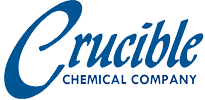Foaming is an undesirable side effect of many industrial processes, as it can reduce processing and storage capacity, decrease operating efficiencies, and create problems with product quality and performance. To effectively control these issues, it is necessary to chemically break the films of liquid surrounding gas bubbles with a silicone defoaming agent, or prevent the foam films from forming in the first place with an antifoaming agent.
Silicone-based foam control additives are often the most cost-effective and efficient options for preventing and controlling foam. Due to their low surface tension, silicones spread evenly and rapidly over a foam film, facilitating penetration and collapse of the foam. They also possess the advantage of being non-contaminating, since they are inert and are typically effective at much lower concentrations than non-silicone defoamers.
Within the complete Foamkill™ line, Crucible offers several types of silicone defoaming agents and antifoaming agents that provide highly effective foam control in a variety of applications and operating conditions. These include:
- 100% active silicone compounds for nonaqueous and certain aqueous systems (detergents, hydrocarbon scrubbing, cutting oils, glycol formulations, etc.)
- Silicone emulsions for easy dispersion in aqueous media
- Solvent dispersions primarily for nonaqueous paints, coatings, inks, & oil & gas applications
- Ready-to-dilute silicone concentrates for general foaming applications
Foamkill Silicone Antifoam Compounds
Foamkill Silicone Antifoam Compounds are special 100% active products designed to give optimum foam control and foam prevention in non-aqueous and certain aqueous systems. All Foamkill compounds are resistant to product separation and are easy to handle, low to medium viscosity fluids. They are chemically inert and resistant to oxidation. Foamkill compounds are effective even at high temperatures; they are non-volatile, and have flash points above 600oF.
Foamkill Silicone Emulsions for Aqueous Solutions
Foamkill silicone emulsions are available for various industries to meet their specific defoaming requirements, including:
- Foamkill 810, 830, S-20, 836A, 852, 875, R-22, CPD and FBF are useful in aqueous systems of all types. They are very efficient in preventing and suppressing foam formation in aqueous systems of all types.
- Foamkill FBF is a mixture of silicone and organic compounds and is extremely stable under high shear and boiling conditions. It also acts as an effective wetting agent in many applications.
- Foamkill 852 is the most “fisheye-free” among silicone-based defoamers. It is an excellent candidate for critical defoaming applications.
- Foamkill 875 is an organo-silicone compounded defoamer, particularly effective in water-based inks, paints and adhesives, starch solutions, cutting oils, and detergent solutions.
- Foamkill R-22 is a concentrated silicone emulsion defoamer primarily for use in wastewater treatment and agrochemicals.
Properties
- Type: Nonionic emulsion blends of silicone and non-silicone materials.
- Viscosity (25oC): Foamkill™ 810, 830, S-20, 836A, 852, 875, R-22, CPD and FBF are low viscosity emulsions in the range of 800 to 1,400 cps. Foamkill™ 810 is a slightly higher viscosity emulsion averaging 3,000 to 4,500 cps.
- pH: 7.6 ± 0.5
- Weight: 8.3 ± 0.1 lbs per gallon
- Color: White
- Storage: Over one year minimum. Not affected by repeated freezing and thawing. All Foamkill products can be autoclaved with no effect on stability or performance. Foamkill 810 and 830 should be stirred after autoclaving to insure product uniformity.
Applications
- Inks & Graphic Arts – Minimizes foam for consistent, high-quality prints.
- Metalworking Fluids – Enhances performance and longevity of cutting and machining processes.
- Waste & Water Processing – Controls foam for smoother operations and better water quality.
- Adhesives – Maintains product consistency and reduces foam-related defects.
- Paints & Coatings – Ensures smooth application and defect-free finishes.
- Paper & Paperboard – Reduces foam during pulp processing and paper production.
- Chemical Compounders – Supports efficient processing and product integrity.
- Food-Grade Processes – Controls foam safely in food production applications.
- Textiles – Minimizes foam to preserve fabric quality and processing efficiency.
- Janitorial Supply – Enhances cleaning formulations by controlling foam in detergents and cleaners.


